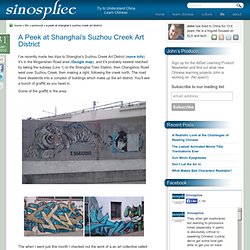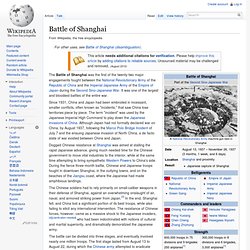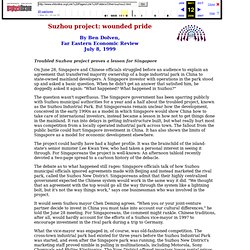

Biodigital Architecture Master - HOME. PTang Studio Ltd. 10+ Competition. Suzhou Creek in Shanghai google map - Google Custom Search. A Peek at Shanghai’s Suzhou Creek Art District. I’ve recently made two trips to Shanghai’s Suzhou Creek Art District (more info).

It’s in the Moganshan Road area (Google map), and it’s probably easiest reached by taking the subway (Line 1) to the Shanghai Train Station, then Changshou Road west over Suzhou Creek, then making a right, following the creek north. The road there deadends into a complex of buildings which make up the art district. You’ll see a bunch of graffiti as you head in. Some of the graffiti in the area: The when I went just this month I checked out the work of a an art collective called Liu Dao (六岛), AKA island6.
Yesterday I checked out the exhibits at “Things from the gallery warehouse 2” [PDF intro]. In the Fiction between 1999 & 2000 (2000), Hu Jieming takes on a more universal challenge, the daunting proliferation of media and information engendered by the Internet. I liked this one a lot… The piece actually makes up a maze that you can wander through. Recherche - - GEO communauté photo. Battle of Shanghai. The Battle of Shanghai was the first of the twenty-two major engagements fought between the National Revolutionary Army of the Republic of China and the Imperial Japanese Army of the Empire of Japan during the Second Sino-Japanese War.

It was one of the largest and bloodiest battles of the entire war. Since 1931, China and Japan had been embroiled in incessant, smaller conflicts, often known as "incidents," that saw China lose territories piece by piece. The term "incident" was used by the Japanese Imperial High Command to play down the Japanese invasions of China. Although Japan had not formally declared war on China, by August 1937, following the Marco Polo Bridge Incident of July 7 and the ensuing Japanese invasion of North China, a de facto state of war existed between China and Japan. The battle can be divided into three stages, and eventually involved nearly one million troops. Documentary film on Japanese Shanghai invasion. Etymology[edit] Background[edit] Strategic reasons[edit] Suzhou Industrial Park. The art sculpture of Harmony, one of the icons in Suzhou Industrial Park Suzhou Industrial Park, officially China-Singapore Suzhou Industrial Park (simplified Chinese: 中国—新加坡苏州工业园区; traditional Chinese: 中國—新加坡蘇州工業園區; pinyin: Zhōngguó—Xīnjiāpō Sūzhōu Gōngyè Yuán Qū), abbreviated as SIP, is a county-level administrative area located in Suzhou, China with significant Singaporean input.

In the late 1990s, the heavy losses incurred by the park caused a minor scandal in Singapore.[1] Background[edit] As China's modernization drive gained momentum in the late 1980s, many Chinese delegations visited Singapore, a southeast Asian nation that achieved notable economic success within 30 years of independence. The Chinese visitors were eager to learn modern management methods, while Singapore was also planning Economic Regionalization, which focused on overseas investment.
In 1992, the idea of developing a modern industrial township with Singapore experience was broached. Suzhou project: Wounded pride by Ben Dolven, FEER July 8, 1999. Troubled Suzhou project proves a lesson for Singapore On June 28, Singapore and Chinese officials struggled before an audience to explain an agreement that transferred majority ownership of a huge industrial park in China to state-owned mainland developers.

A Singapore investor with operations in the park stood up and asked a basic question. When he didn't get an answer that satisfied him, he doggedly asked it again: "What happened? What happened in Suzhou? " The question wasn't superfluous. The project could hardly have had a higher profile. The debate as to what happened still rages: Singapore officials talk of how Suzhou municipal officials ignored agreements made with Beijing and instead marketed the rival park, called the Suzhou New District. It would seem Suzhou mayor Chen Deming agrees. What the vice-mayor was engaged in, of course, was old-fashioned competition. The agreement to transfer ownership looks like a partial exit strategy. Map Shanghai Suzhou Creek Office. Suzhou Creek. Shanghai: city guide - Damian Harper, David Eimer.